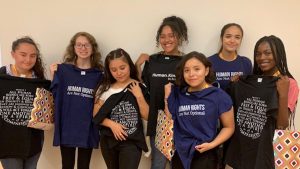
Scholarly publishing is often considered an exclusive domain, accessible primarily to established academics and seasoned researchers.
However, one groundbreaking journal is challenging that norm by offering high school students a rare opportunity to contribute to critical global discussions. Critical Debates in Humanities, Science, and Global Justice (Critical Debates HSGJ) is a peer-reviewed, open-access international journal dedicated to showcasing the intellectual rigor and research capabilities of emerging young scholars.
At the helm of this innovative initiative is Rita Verma, PhD, professor in the Adelphi University Ruth S. Ammon College of Education and Health Sciences. As the founder and editor in chief, Dr. Verma envisioned a scholarly space where high school students could engage in serious academic inquiry and share their insights on pressing global issues.
“This journal aims to build a dialogue around critical viewpoints, lenses and debates about the challenges facing the world,” Dr. Verma said. “We encourage submissions that analyze these issues through diverse perspectives, whether it’s using math and science to understand public policy debates or the humanities and arts to explore justice and human rights.”
Scholarly Recognition for Young Writers

High school students in Dr. Verma’s summer program on human rights.
The journal has quickly gained recognition, earning a reputation as a leading publication for high school research. An advisory board of esteemed scholars from prestigious institutions supports its mission, helping to ensure the quality and academic rigor of the content. To date, the journal has published four issues, featuring a wide array of topics that range from climate change and political systems to art’s role in democracy and social media ethics.
A key highlight of the journal is the diversity of its contributors and their research topics. High school students from across the globe have submitted thought-provoking articles that reflect their unique backgrounds and academic passions. For example, a student from San Jose, California, examined the U.S. political systems that contribute to agricultural water contamination, while a researcher from Miami, Florida, explored the balance between misinformation and censorship on social media. From India, an article on counter-hegemony through art in citizenship protests sheds light on the power of activism. These diverse perspectives not only enrich the journal’s content but also demonstrate the journal’s commitment to fostering a truly global academic dialogue.
Dr. Verma’s role as editor in chief extends beyond overseeing submissions. She meticulously reviews each article before sending it to peer reviewers from across the country. Only the most exemplary research pieces are selected for the quarterly journal, while other strong submissions find a home in the journal’s blog section. The review process maintains high academic standards, fostering an environment where young researchers can develop their skills and gain exposure to experts in their respective fields.
“There is such an incredible variety in the topics we receive,” said Dr. Verma. “I have been fascinated by the depth of inquiry, thoughtfulness, rigor and creativity in these articles. It is a testament to the unique nature of research and the intellectual potential of young scholars.”
Bringing the Real-World Into Academics

High schoolers visiting the Adelphi campus for peace and art.
Beyond serving as a platform for student research, Critical Debates HSGJ plays an essential role in bridging the gap between academic research and real-world issues. From climate change solutions to discussions on trauma, war, rights and oppression, the journal provides a space for critical thought and civic participation.
Dr. Verma and her editorial team are committed to making the submission process seamless and accessible for students worldwide. With an expanding international contributor base, the journal continues to grow as a global platform for young researchers. Looking ahead, exciting new initiatives are on the horizon, including a research conference for published authors and a collaborative research proposal submission to the American Educational Research Association (AERA) conference, which recently launched an initiative to engage high school students in academic presentations.
“The future of this journal is bright,” said Dr. Verma. “We hope to continue expanding our global reach and fostering a new generation of scholars who recognize the value of their voices in academic discourse.”
For young researchers interested in academia and publishing, Dr. Verma offers a piece of valuable advice: “We are moving further away from intellectual exchange that requires patience for the development of ideas. Engage passionately with your areas of interest, develop your voice as a scholar and embrace the transformative journey of research.”
Through Critical Debates HSGJ, high school students from around the world are proving that they belong in the academic conversation—and that their ideas have the power to shape the future.